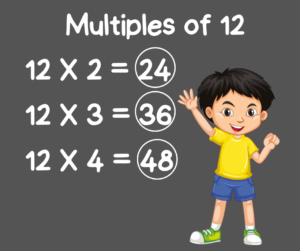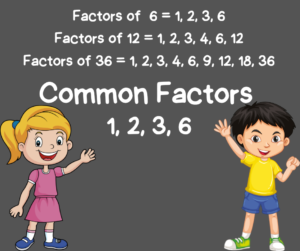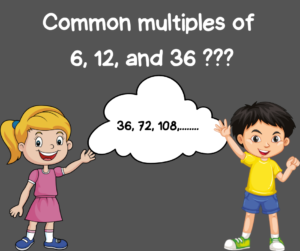Introduction
Although factors and multiples are entirely different concepts, they are related. To determine the factors, we divide the given number by another number, whereas multiples of the given number can be obtained by multiplying the given number by any other number. Multiplication is involved in both ideas. To obtain a given number, we multiply two numbers; the two numbers we multiplied are referred to as the obtained number’s factors.
For example, 4 x 5 = 20. Therefore, 20 is a multiple of 4 and 5, and 4 and 5 are factors of 20.
The number that is the factor of two or more numbers is referred to as the common factor. GCD (Greatest Common Divisor) and HCF (Highest Common Factor) are terms that relate to this idea.
The common multiple is the number that is a multiple of two or more other numbers. The Least Common Multiple, or LCM, is related to this idea. Different divisibility criteria can be used to determine whether a given number is divisible by another without actually conducting the division operation.
Factors
A number must divide completely, leaving no remainder, to be the factor of any other number. In other words, we can also say that the divisor is a factor of the dividend if a number (the dividend) is exactly divisible by any other number (the divisor), leaving no remainder.
For Example: Let’s take the number 36, if we check for factors of 36, we have
36 = 1 x 36 = 2 x 18 = 3 x 12 = 4 x 9 = 6 x 6

Properties of Factors
- If a division of a number by another number leaves no remainder, then that second number is said to be the factor of the first number.
- A number can only have a finite number of factors.
- Prime numbers are those that only have themselves and the number 1 as factors.
- Composite numbers are those that have more than two factors.
- Finding a number’s factors involves using division.
- The obtained factors are always less than the initial number.
Multiples
Multiples are numbers created by multiplying the given number by integers. The multiplication table shows the multiples of a given number.

Properties of Multiples
- The results of multiplying an integer by a given number are referred to as the given number’s multiples.
- There are an infinite number of multiples of a number.
- Finding a number’s multiples requires the use of multiplication.
- The multiples of a given number exceed or are equal to that number.
- Every number is a multiple of itself.
Difference between Factors and Multiples
Some differences between factors and multiples are given in the table below:
| Factors | Multiples |
| Factors are exact divisors of a number. | Multiple has the number as its exact divisor. |
| Factors of a number are finite. | Multiples of a number are infinite. |
| Factors are obtained by division. | Multiples are obtained by multiplication. |
| Factors of a number are always less than or equal to the number itself. | Multiples of a number are always greater than or equal to the number itself. |
Common Factors and HCF
A common factor is any factor that two or more numbers share.

For example, take 35 and 42
Factors of 35 = 1, 5, 7, 35
Factors of 42 = 1, 2, 3, 6, 7, 14, 21, 42
Both 35 and 42 have some factors such as 1 and 7 that are common to both, these are known as common factors of 35 and 42.
Now, in this case in the list of common factors, 7 is the largest number, or we can also call it the highest common factor, i.e., HCF.
Thus, HCF or the highest common factor of a set of numbers is defined as the largest number that divides all the numbers in the given set of numbers.
Common Multiples and LCM.

Common multiples are those multiples that are shared by two or more different numbers.
For example, take 6 and 8
Some multiples of 6 are, 6, 12, 18, 24, 30, 36, 42, 48, 54, 60 etc.
Some multiples of 8 are 8, 16, 24, 32, 40, 48, 56, 64, 72, 80 etc.
Here, both 6 and 8 share some common multiples such as 24, 48 and infinitely many more. These are known as common multiples of 6 and 8.
In this case, in the list of common multiples, 24 is the smallest, or we can also call it the least common multiple, i.e., LCM.
Thus, LCM or least common multiple of a set of numbers is defined as the smallest number that is a multiple of or is divisible by all the numbers in the given set of numbers.
Solved Examples
Question: Find the list of factors of 36.
Solution: We know that 1 and the number itself, i.e., 36, are the two trivial factors, so we will start dividing by the next number.
36 ÷ 2 = 18, Thus, 2 and 18 are two more factors of 36, moving to the next number
36 ÷ 3 = 12, Thus, 3 and 12 are two more factors of 36, moving to the next number
36 ÷ 4 = 9, Thus, 4 and 9 are two more factors of 36, moving to the next number
Clearly, 36 is not divisible by 5 since it doesn’t have 5 or 0 in the unit place, moving to the next number
36 ÷ 6 = 6, Thus, 6 is the final factor of 36.
Factors of 36 are 1, 2, 3, 4, 6, 9, 12, 18, and 36.
Summary
This article provides insight into the topic of Factors and Multiples, while also shining a light on the concept of common factors and common multiples. To completely divide another number without leaving any remainder, a number must be the factor of that other number. The multiples are the results of multiplying the given number by integers. Common multiples are those multiples that are shared by two or more different numbers. A common factor exists for two or more different numbers.
Frequently Asked Questions (FAQs)
1. What are Factors and Multiples?
Ans. Factors of a number are defined as the number that divides the given number completely and evenly without leaving any remainder.
Multiples on the other hand are the numbers obtained by multiplying the given number by different integers.
2. What are Prime Numbers?
Ans. Prime numbers are defined as numbers greater than 1 that have only 2 factors, i.e., 1 and the number itself. Some examples of prime numbers are 2, 3, 5, 7, 11, etc.
3. What is the Fundamental Theorem of Arithmetic?
Ans. The fundamental theorem of arithmetic states that every number can be broken into the product of some prime numbers, also known as its prime factors. This product is unique to a number and cannot ever change no matter how you find it, only the order of the product changes.
4. What is the Relationship between HCF and LCM of two Numbers?
Ans. The relationship between is defined as: The product of HCF and LCM of two numbers is equal to the product of the two numbers.
HCF (a, b) × LCM (a, b) = a × b